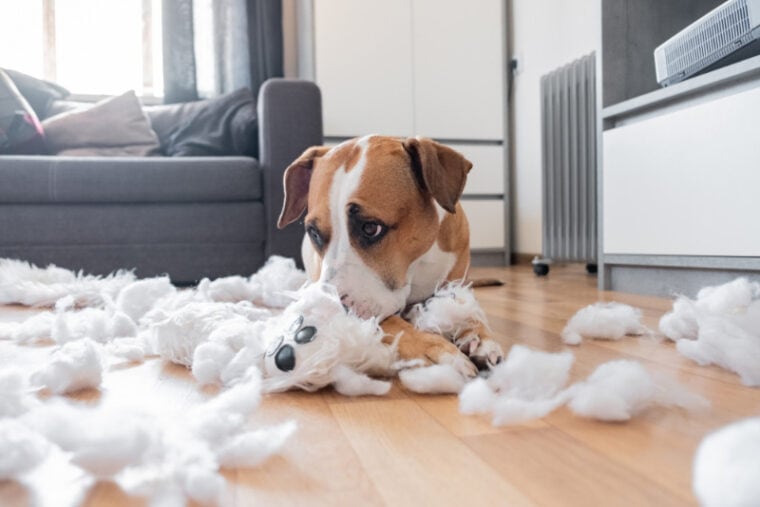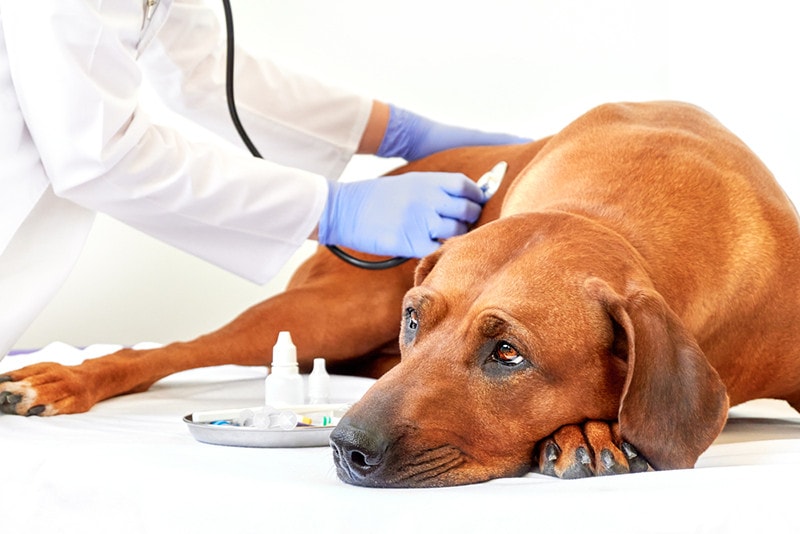
Click to Skip Ahead
Dogs are inquisitive and generally explore their environment not only with their eyes, nose, and ears but also with their mouth. Unfortunately, this may lead a dog to eat something that they should not have. Dogs may consume inedible objects like rocks, clothing, food wrappers, sticks, or even parts of toys, not knowing that these may be dangerous to them.
Occasionally, dogs may vomit up the object, or it passes out of the GI tract with the rest of the stool uneventfully. In other cases, it may become stuck somewhere along the digestive tract, causing an obstruction and a potentially life-threatening situation. If your dog ate toy stuffing, keep in mind that it could become a foreign body obstruction that promptly requires surgery to prevent further complications. Toy stuffing is not digestible, and dogs should be prevented from eating it.
What Are the Signs of a Foreign Body Obstruction?
Signs of an obstruction in dogs may include:

What Do I Do If My Dog Eats Toy Stuffing?
Depending on the components of the stuffing and the quantity ingested, it is advised to contact your veterinarian or emergency clinic for advice. They may recommend that you bring in your dog to safely induce vomiting or retrieve the object with an endoscope while your dog is under anesthesia to prevent an obstruction. Depending on the material, inducing vomiting may actually worsen the problem because it damages the esophagus, the object may get stuck in the esophagus on its way out, or it causes choking or aspiration pneumonia. This is why you should never induce vomiting at home without consulting with a veterinarian first.
In some cases, it may be okay to monitor your dog at home to wait for it to pass naturally. Increasing the fiber content in your dog’s diet may help bulk up the stools to allow easier passing of the material, but this should only be done under the advice of your veterinarian. Any abnormal behavior or signs of an obstruction should be addressed right away.
How Will My Veterinarian Treat an Obstruction?
Suspected foreign body obstructions are typically diagnosed with assistance from bloodwork, abdominal ultrasound, and X-rays, with the use of contrast dye or barium to determine where along the GI tract the obstruction has occurred. Once this is determined, endoscopy or surgery may be the next step to remove the foreign material. This is vital because the obstruction can cut off the blood supply to the intestine, causing it to die. It may lead to irreparable damage, shock, and death.
Once the obstruction is removed, your veterinarian may want to observe your dog for a few days for any complications prior to being discharged with detailed at-home care instructions. Prognosis is usually good with prompt identification and treatment of an obstruction.

How Do I Prevent My Dog From Eating Toy Stuffing?
If your dog enjoys eating the stuffing from toys, provide alternative toys without stuffing. Keep all stuffed toys and plush animals away from your dog. Use barriers like baby gates to prevent access to rooms with stuffed toys. Spray a chewing deterrent, such as a bitter spray, in areas that you want your dog to avoid. Placing a basket muzzle on your dog will prevent them from chewing stuffed toys and other undesirable objects while still enabling them to drink water and eat food.
If this is not possible, closely monitor your dog while they’re playing with toys. Once your dog has chewed through the toy to the stuffing, immediately remove it. All toys and treats should always be closely monitored by you when given to your dog.
How Do I Ensure That My Dog Is Eating a Healthy Diet?
Choosing a healthy diet is based on your dog’s age, size, and lifestyle factors to ensure that their nutritional needs are being met. Dog food brands that are compliant with both the Association of American Feed Control Officials (AAFCO) and the World Small Animal Veterinary Association (WSAVA) are recommended. The WSAVA Global Nutrition Committee produces guidelines to ensure that dogs are on an ideal nutrition plan that is tailored to their individual needs. The companies that follow AAFCO and WSAVA guidelines include Purina, Hill’s, Royal Canin, Iams, and Eukanuba.
Conclusion
Do not allow your dog to eat toy stuffing, as it could cause a life-threatening foreign body obstruction. Monitor your dog with all toys and treats to prevent complications, including choking. Provide alternative toys, treats, or activities if your dog is prone to eating toy stuffing. A basket muzzle may be required if monitoring or removal of toys is not possible.
See also:
- My Dog Ate Insulation: Our Vet Explains What to Do
- Hamster vs Guinea Pig: Which Pet Should You Get? (With Pictures)
Featured Image Credit: Aleksey Boyko, Shutterstock








